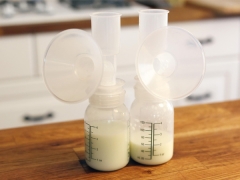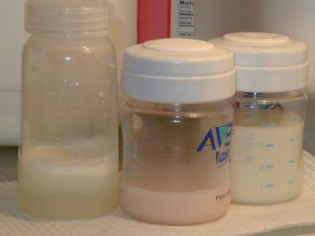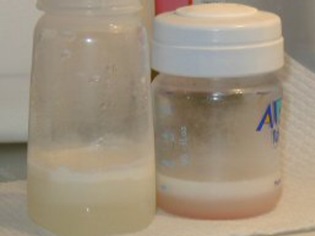What does breast milk look like and how does it taste?
Many young mothers do not know how female milk should normally look like. They may be frightened when they see a strange, in their opinion, color or stratification of the expressed fluid. This may affect breastfeeding. What could it be?
Special features
Its appearance changes constantly. The same can be said about his composed, read more about this in another article.
The type of colostrum is not similar to the type of mature milk. Milk can change during the day, and even during one feeding. At the same time the structure as much as possible corresponds to needs of the baby during its development. For example, if a baby or mother is sick, more immune factors are found in the milk.

During storage, it is usually separated, separated into two layers. This is different from the mixture and from cow's milk. Even if you hold the expressed milk for a short time on the table at room temperature, you will see how it will begin to divide into layers. In this case, the top layer of “cream” - fatter milk - may be thin or thick.
Every nursing mother is important to know:
- Any changes in color and texture may not indicate its corruption. The spoiled product has a different taste and smell.
- By the appearance of milk it is impossible to determine its fat content.
Options
Consistency
- The structure immediately after decanting is often homogeneous, but sometimes lumps are also found.
- A watery or fluid look is the norm.
- Split milk can return uniformity by gently mixing it in a container with rotating movements (do not shake the product).
Colour
- Colostrum in color can be from orange to light yellow. The density of such milk is increased, and in its composition there are a lot of antibodies.
- Mature milk may have a white color, but it may also have a yellow, blue or creamy tint.
- No need to think that in the presence of a bluish tint, it is non-greasy and not nutritious. This color may be in absolutely normal human milk.
- It can become orange, as well as greenish, if the woman's diet contains products that contain natural dyes. From carrot salad or pumpkin dishes in the mommy's menu, it can get an orange hue. A greenish tint may appear due to eaten broccoli, spinach or seaweed.
- Also, the acquisition of a shade can be associated with the use of food with artificial dyes or drugs.
- The pink shade often appears due to blood entering the breast milk from the damaged nipples or a burst capillary. This does not impair its characteristics, so it can be given to the child. Often, the blood that has got into the milk settles at the bottom of the bag or container, so it is best to pour the product into another bottle and give the crumbs some milk without blood.
Mom's “front” milk is less fat, it is very different in color and consistency from the “back”, which is why pediatricians during one feeding advise using only one breast.
Smell and taste
- The usual smell - sweetish, rather pleasant, milky.
- The taste is normally sweet.
- The smell, as well as the taste, can be influenced both by the medicines used by the mother and the products in her menu.














